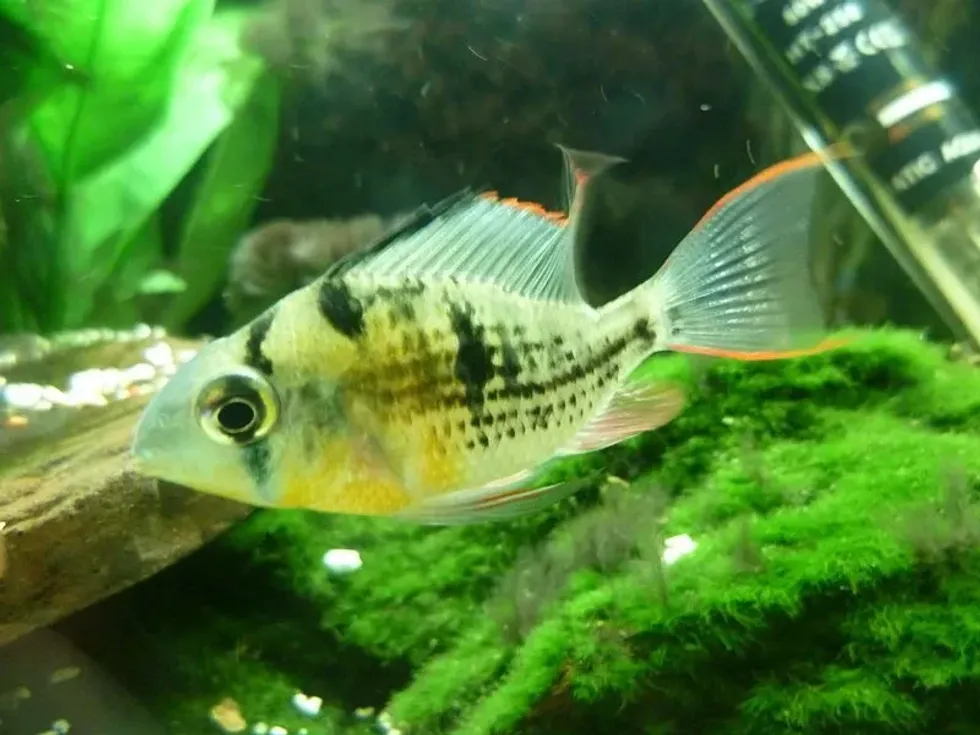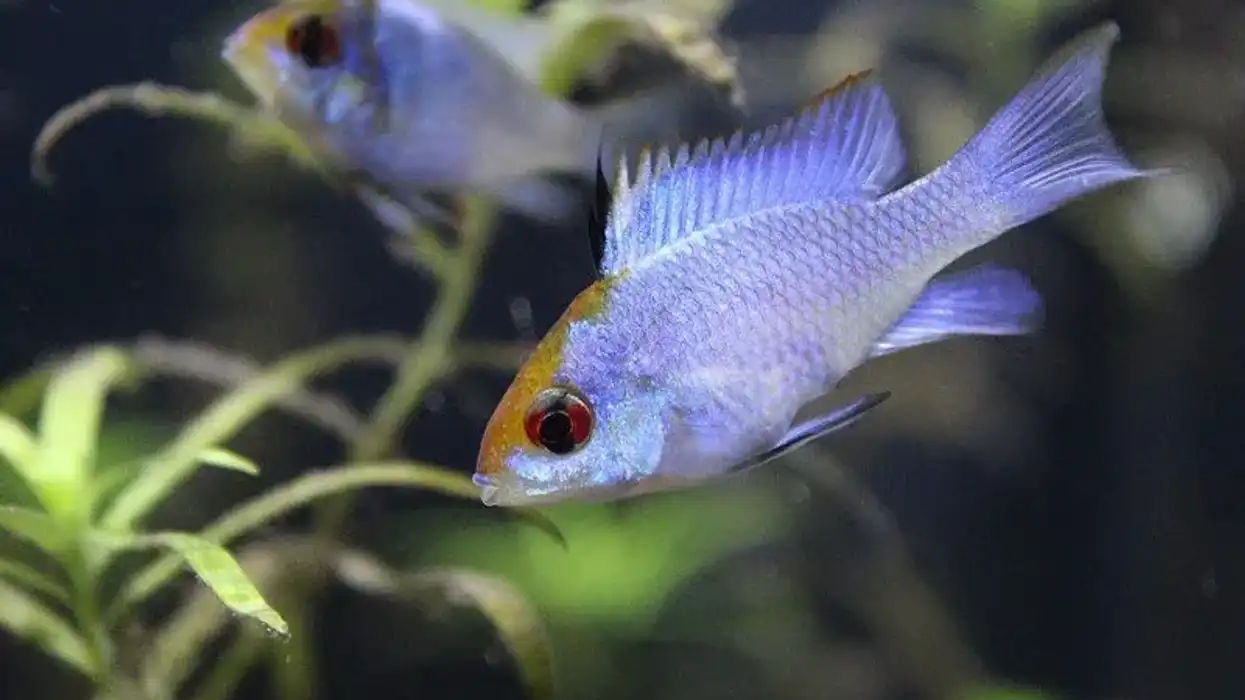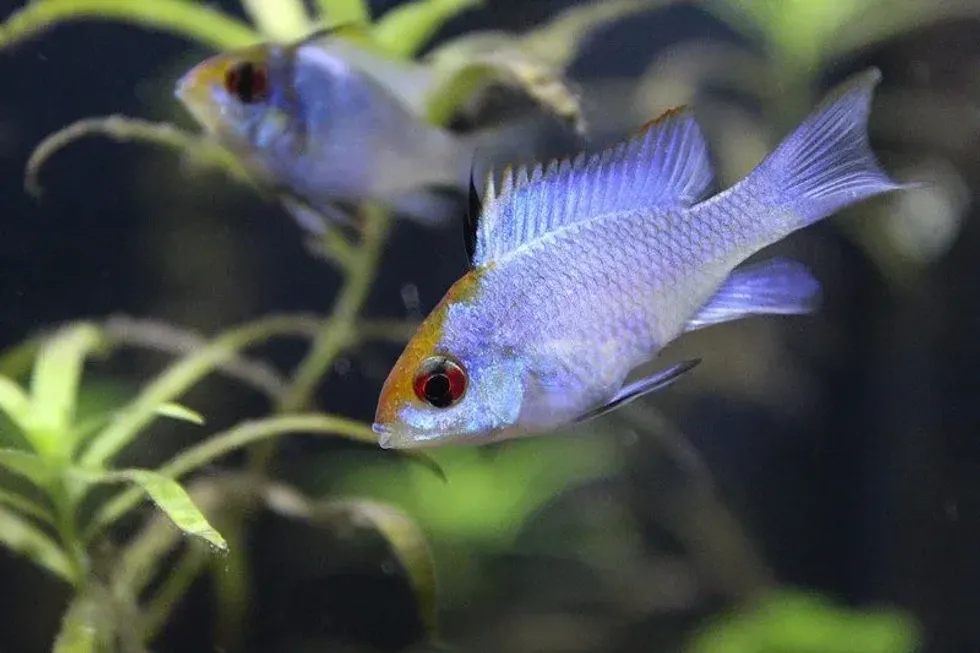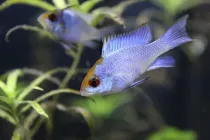Fun Ram Cichlid Facts For Kids

The ram cichlid (Mikrogeophagus ramirezi), belongs to the family Cichlidae in the order of perch-like fish. German blue rams are endemic to the river basin of Orinoco and are found in the savannas of Venezuela, Colorado, and South America.
There are four species of ram cichlids, namely, Bolivian ram cichlid, German blue ram cichlid, golden ram cichlid, and electric blue ram cichlid. Electric blue rams are freshwater fish and usually show a peaceful temperament if kept in a tank.
German blue rams are territorial and become aggressive when other fish try to invade their territories. The German blue ram fish are good parents and do not abandon their offspring immediately after they are hatched.
The electric blue ram (Mikrogeophagus ramirezi) is also very shy and hides quickly in its pits if stressed or threatened. A golden ram cichlid is considered the rarest sub-species of this fish. After reading these interesting facts about the ram cichlid, do check our other articles on peacock cichlid facts and convict cichlid facts.
Ram Cichlid Interesting Facts
What type of animal is a Ram Cichlid?
The ram cichlid is a type of freshwater fish that lives at a temperature of 22-28 degrees Celsius. German blue rams are omnivorous and can feed on anything that they are offered. German blue ram fish do not show aggressive behavior until provoked by other fish.
What class of animal does a Ram Cichlid belong to?
A ram butterfly cichlid is a freshwater fish found mainly in Venezuela, Columbia, the Orinoco River Basin, Amazon River Basin, and South America. German blue rams are very colorful and are mostly found in aquariums where they are bought and kept as pets.
If a ram cichlid is taken good care of, it can live its entire lifespan of four years along with other species of fish in a water tank of 10-20 gallons.
How many Ram Cichlids are there in the world?
The IUCN has not evaluated the population of ram cichlids, and their conservation status is Not Listed. However, their population is considered to be stable and is not listed as near threatened or endangered.
However, the population of ram cichlids is seen to be decreasing due to pollution of water bodies and lack of oxygen due to chemicals. A lack of hiding spots and diseases is also a major reason for their decline.
Where does a Ram Cichlid live?
Ram cichlids live in the savannas of Columbia and Venezuela. German blue rams are also found in the river basins of the Amazon and the Oronoco. German blue ram fish can live in freshwater and will die if the water gets hard or murky. They feed on pellets, live worms, and other food.
What is a Ram Cichlid's habitat?
Dwarf cichlids can survive in a water tank that is well-oxygenated and has pits and rocks where the cichlid can hide. Plants should also be present in the water tank.
Only freshwater should be filled in the tank, and German blue rams will be susceptible to diseases if the tank becomes murky. These fish tend to become stressed if they are unable to locate suitable hiding places.
Who do Ram Cichlids live with?
Ram cichlids live in pairs or can live alone as well. It is not necessary that when a pair of ram cichlids are bought and kept in the tank, they will breed with each other. Breeding ram cichlids is a difficult task.
How long does a Ram Cichlid live?
The average lifespan of a ram cichlid is four or five years. German blue ram fish generally do not live longer than that. Ram cichlids need extreme care, and their tank needs to be cleaned daily.
They can easily be diagnosed with diseases if the water becomes murky. A dwarf cichlid should be fed with worms like bloodworms and caterpillars, and pellets, which is their staple food. Ram cichlids can also die due to stress or tuberculosis.
How do they reproduce?
When a German blue ram is stressed, it will not spawn. The breeding starts with the formation of male and female pairs and the male becomes quite aggressive towards other male cichlids.
After reproduction, the female ram cichlids lay eggs that are only 0.03-0.05 in (0.76-1.27mm) long. These eggs are adhesive and get attached to flat rocks or small depressions which are dug by the parents. The eggs are taken care of by the male.
What is their conservation status?
The conservation status of ram cichlids is currently unknown. German blue Rams are not evaluated or listed by the IUCN. However, their population is stable and is listed as Not Extinct. Dwarf cichlids are endemic to the Orinoco River Basin and the savannas of Venezuela and Colombia.
German blue ram fish are freshwater fish that are also found in South America. German blue rams can die of many diseases like tuberculosis and difficulty breathing. They can also die due to extreme stress.
Ram Cichlid Fun Facts
What do Ram Cichlids look like?

Ram Cichlids have orange, red, and yellow spots on their body and are very colorful. The males have elongated, stout bodies as compared to the females. The Bolivian Ram Cichlid also has spots of pink and yellow on it.
Different species of the Ram Cichlid vary in appearance, length, and body weight. The Green terror Ram Cichlid has an orange shade on the back of the tail and ends of the fin. German Blue Rams have distinctive black spots and develop a bulgy head like a flower horn.
How cute are they?
Ram cichlids are very cute and appealing. Their vibrant colors make them a top pet, and German blue ram fish are widely found in many aquariums.
German blue rams are colored yellow, orange, and red. The Bolivian ram cichlid is yellow, pink, black, and silver and is also known as the ruby-crown cichlid. Ram cichlids are also referred to as butterfly cichlids.
How do they communicate?
Ram cichlids use smells and other chemicals to communicate with each other. German blue ram fish are territorial and will scare away other fish and be aggressive towards them.
They will not kill other fish but will hold their ground until they leave. Their behavior is considered to be peaceful as they can live with other species of dwarf cichlids and a male or a female cichlid. Some species of cichlids also use their vibrant body color to show dominance.
How big is a Ram Cichlid?
Ram cichlids have an average body length of 2 in (5cm), while some specimens can attain a length of 3 in (7cm). German blue ram fish only grows to a body length that is only two-thirds of their cousins, the Bolivian ram cichlids. Their body weight is also less than the Bolivian ram cichlid.
How fast can a Ram Cichlid swim?
Blue ram cichlids are sometimes called butterfly ram cichlids due to their iridescent colors. Electric blue ram fish can do well if kept in a 2o gallon tank and are fed with baby shrimp or pellets.
Ram cichlids are less aggressive than Bolivian ram cichlids and live peacefully with other dwarf rams or other species of fish that are not fast-eaters. They are feisty sometimes but move at an average pace underwater. They are quick at hiding in their pits and catching prey to eat.
How much does a Ram Cichlid weigh?
The average weight of a Ram Cichlid is 0.60-0.70 oz (17-20g). The German blue ram cichlid, or the Mikrogeophagus ramirezi, can have body weights of around 0.7 oz.
The four different species of the ram cichlid are the German blue ram cichlid, the golden ram cichlid, the electric blue ram cichlid, and the Bolivian ram cichlid, which all have different weights according to their species.
What are the male and female names of the species?
There are no male and female names for the ram cichlid fish species. Electric blue ram fish are differentiated based on their sex and are called male ram cichlids or female ram cichlids. Some ram cichlids also can change their sex after the process of hermaphroditism is completed. Ram cichlids are capable of producing both eggs and sperm.
What would you call a baby Ram Cichlid?
Baby ram cichlids are called wigglers. These wigglers do not start swimming immediately and will sit on the bottom of a tank or in a safe hiding place in a water body.
Electric blue ram fish will only start swimming after around five days and are constantly fed by their parents. They are not abandoned by the male and the female ram cichlids after birth.
What do they eat?
Ram Cichlids can eat anything that they are fed. Electric Blue Ram fishes are omnivorous and consume plant and animal material.
They eat pellets, worms like bloodworms, and caterpillars. Their staple diet is any live food and flake food. They may not eat anything that they are fed when they are first brought in a new tank, but eventually, they will start eating.
Are they dangerous?
German blue cichlids do not pose any danger to human beings in general and are very easy to keep. Electric blue ram fish must be given special attention sometimes, and any change in swimming behavior or discoloration should be immediately treated as an alarming issue.
German Blue Ram Cichlids are susceptible to many disorders caused due to stress. They may also be diagnosed with Fish Tuberculosis which can be passed onto human beings and is a contagious disease.
Would they make a good pet?
Yes, ram cichlids make good pets and are kept as pets by many aquarium enthusiasts. Their vibrant and colorful body makes them an exotic fish species and is bought by many.
The German ram cichlid is usually a peaceful fish and could live for three years in your water tank of 10 gallons.
The tank size must be large and the water must be fresh, plants must also be installed in the tank. So, you must acquire adequate knowledge of minimum tank size, tank mates, water changes, and water quality required before adopting this fish as a pet
Did you know...
Male blue ram cichlid fish sport bright blue spots on their long, elongated body, which is typically absent in females. They have 12 vertical bars on their stocky body. Females have smaller bodies and generally have dull blue to light blue spots along with silver.
They can be distinguished by analyzing their dorsal fins. All ram cichlids have orange, yellow, and red markings on their body. They can be kept in a gallon aquarium of soft water and good water quality.
These fish usually do well in community tanks but require established aquariums to thrive.
The Ram Cichlid's birth process
Blue Ram Cichlids, if stressed during breeding, do not lay eggs. They only lay eggs when they feel safe while breeding and their eggs are usually found under large, flat rocks.
They have a pink belly and become visibly fat if they are pregnant. A pregnant female Blue Ram Cichlid must be left alone and should be kept in a separate tank. However, they are peaceful fish and tropical fish.
Getting your own Ram Cichlid
Ram cichlids can be bought from any aquarium. They are widely kept as fish pets.
They are freshwater fishes and cannot survive in hard water. A water tank of 10 gallons must be sufficient for any owner to keep the Ram Butterfly Cichlid. The tank must also consist of flat rocks and hiding places for an Electric Blue Ram.
German Blue Ram must be fed with worms and must be well-oxygenated. The owner needs to have a thorough knowledge of the minimum tank size, suitable tank mates, water changes, and water quality required before adopting this fish as a pet
Here at Kidadl, we have carefully created lots of interesting family-friendly animal facts for everyone to discover! Learn more about some other fish including Buenos Aires tetra facts, or Midas cichlid facts.
You can even occupy yourself at home by coloring in one of our free printable Ram cichlid coloring pages.
We Want Your Photos!
More for You
See All
Bachelor of Arts specializing in Linguistics

Martha MartinsBachelor of Arts specializing in Linguistics
Martha is a full-time creative writer, content strategist, and aspiring screenwriter who communicates complex thoughts and ideas effectively. She has completed her Bachelor's in Linguistics from Nasarawa State University. As an enthusiast of public relations and communication, Martha is well-prepared to substantially impact your organization as your next content writer and strategist. Her dedication to her craft and commitment to delivering high-quality work enables her to create compelling content that resonates with audiences.
Bachelor of Arts specializing in English Literature

Deeti GuptaBachelor of Arts specializing in English Literature
A detail-oriented fact-checker with a research-oriented approach. Devika has a passion for creative writing, she has been published on multiple digital publishing platforms and editorials before joining the Kidadl team. Currently pursuing a Bachelor of Arts in English Literature from St.Xavier's College, Deeti has won several accolades and writing competitions throughout her academic career.
Disclaimer
1) Kidadl is independent and to make our service free to you the reader we are supported by advertising. We hope you love our recommendations for products and services! What we suggest is selected independently by the Kidadl team. If you purchase using the Buy Now button we may earn a small commission. This does not influence our choices. Prices are correct and items are available at the time the article was published but we cannot guarantee that on the time of reading. Please note that Kidadl is a participant in the Amazon Services LLC Associates Program, an affiliate advertising program designed to provide a means for sites to earn advertising fees by advertising and linking to Amazon. We also link to other websites, but are not responsible for their content.
2) At Kidadl, we strive to recommend the very best activities and events. We will always aim to give you accurate information at the date of publication - however, information does change, so it’s important you do your own research, double-check and make the decision that is right for your family. We recognise that not all activities and ideas are appropriate for all children and families or in all circumstances. Our recommended activities are based on age but these are a guide. We recommend that these ideas are used as inspiration, that ideas are undertaken with appropriate adult supervision, and that each adult uses their own discretion and knowledge of their children to consider the safety and suitability. Kidadl cannot accept liability for the execution of these ideas, and parental supervision is advised at all times, as safety is paramount. Anyone using the information provided by Kidadl does so at their own risk and we can not accept liability if things go wrong.
3) Because we are an educational resource, we have quotes and facts about a range of historical and modern figures. We do not endorse the actions of or rhetoric of all the people included in these collections, but we think they are important for growing minds to learn about under the guidance of parents or guardians.







